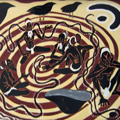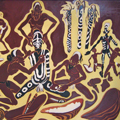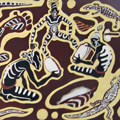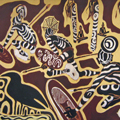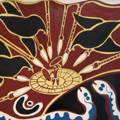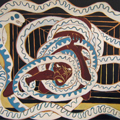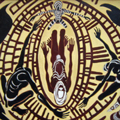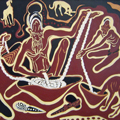Chant for Kurdaitcha was the second of four series inspired by Aboriginal ritual and legend. It followed The Cord to Altcheringa (1953) and appeared shortly before Love Magic. In 1956 the artist produced the last of the set: ten large panels depicting The Legend of the Black Swan.
All four series reflect Elizabeth Durack’s affinity with an Aboriginal view of the world. Using a limited palette of ochre colours she created works, striking in drama and design, that combined an essence of Aboriginality within her own perceptions and style.
The works stem partly from personal experience, from familiarity with ancient masterpieces on rock faces in northern Australia, and from lessons learnt from Jubul, a bark painter from Arnhem Land.
The paintings are a synthesis of two worlds. Detailed notes elucidate certain aspects of them yet, necessarily, not all can be explained.
*
The following notes (and the notes accompanying each painting) were included with the catalogue when this series of paintings was first presented at St Catherine's College, University of Western Australia in 1954:
To the Australian Aborigine, the Kurdaitcha man, with his blackened skin and white feather markings, is a more dread figure than that of any evil spirit.The Kurdaitcha is no 'legendary' character and his practice still survives in remote parts. In Aboriginal belief when death strikes its cause is attributed not to some natural occurrence or actual deed but to the influence of enemy magic.
This series of twelve pictures tells the story of Kurdaitcha — the reprisal whereby revenge on the enemy believed to have brought about a death is effected.
The most used Kurdaitcha sign is a semi-circle of black pipe-clay bordered with white and a black dot in the centre. This sign often occurs within the designs of these paintings. It is used in body markings, on shields carried during the practice and often on rock faces to show that Kurdaitcha passed that way,
In the execution of these paintings I have used the bark-painting method of the Aborigine's own devising. For my knowledge of this I am indebted to an old artist and friend called Jubul. Although I knew him in the far north of this state he came originally from the Northern Territory. He used to visit me in a grass studio in which I worked on the banks of the Ord River. He watched me at work with great interest. He was always amazed and usually highly amused to see a likeness emerging in a portrait.
One day in an effort to tactfully get rid of him I asked him if he himself painted. He told me that he had done so in his own country before he came to the Kimberlies. He told me it was painting of “‘nother kind" to that which I was doing. I gave him a large sheet of paper and a soft pencil and told him to do a drawing for me and bring it back the next day,
I was of course familiar with the bark-paintings of Arnhem Land and the rock paintings through the district, but I was not prepared for what occurred on his next visit. Up the river bank came Jubul with several large pieces of bark and some tins containing ground up ochres of yellow, reds and white, He first expounded on the uselessness of paper as a medium because it was so flimsy it broke into holes with the first strokes. He then explained how much of bark-painting is simply 'play-about' and must on no account be confused with the sacred forms and figures to be seen in the holy places and caves were they have stood since the beginning of Time and where they are annually renewed or retouched at the Rites of Increase ceremonies. (Jubul was an old man — most of these Rites have fallen into disuse.)
A bark painting sets out to tell a story. It is about something, some incident of the hunt, some passing event. Watching Jubul at work I was able to absorb the method. He would set out to say something then lose himself in the sheer enjoyment of formal composition and design. Practically every line had its own significance although sometimes additions were made that had no meaning but were put in (to use Jubul's expression) for 'look nice'. It was his way of explaining an instinctive and innate sense of perfect balance and design — a balance and design not of trite repetition and stiff juxta-positioning but which in the completed picture, added up to something completely satisfying. Perspective and 'drawing' became secondary to arrangement and meaning.
It seems to me that in no other way could the fantastic world of reality and unreality in which the Aborigine lives be better expressed than through the classic bark-painting method. In these paintings I have kept them for the most part 'right way up' which is not considered in bark-paintings where they are done on the ground and looked at by a circle of observers, and not produced — as our paintings — to be hung horizontally upon walls. I have taken certain liberties as, for instance, in the use of more 'drawing' than Jubul would have put into the human figures. I have used 20th century materials but have adhered to the original colour-range of the bark painting — the black (charcoal), yellow (ochre), red (light and dark red ochre and blood) and white (pipe-clay). The use of the blue in Nos, 6 end 7 of this series is legitimate within the Aboriginal palette as this colour is obtained in small quantities from crushing the fruit of a certain flower.
I hope I may have managed to convey to the observer something of the original spirit of these people before a rich and florescent culture crumpled under history,
Nowadays one needs must ransack the wilderness for traces of a way of life that once covered a whole continent, but still much may be felt of the past, if not always seen, in those parts of Australia where the white man is still the stranger. In such places one becomes aware of the delicate threads of mysticism surviving and pristine, and one can still see, stamped indelibly on the faces, the savage enduring dignity.
ED 1954
